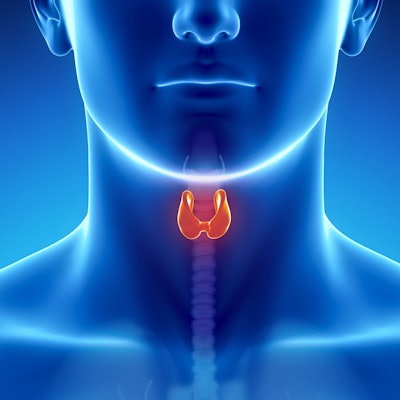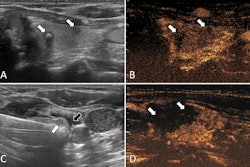
Radiofrequency (RF) ablation is a safe and effective option for patients with small papillary thyroid tumors, according to a study published February 10 in JAMA Otolaryngology -- Head and Neck Surgery.
Dutch investigators analyzed published reports on the use of radiofrequency ablation in patients with papillary thyroid microcarcinomas (PTMC) and found the procedure resulted in the complete disappearance of tumors in 79% of cases, with few complications.
"Radiofrequency ablation could be envisioned as step-up treatment after local tumor growth under active surveillance or initial treatment in patients with anxiety about active surveillance and wishing to avoid surgery," wrote corresponding author Dr. Tessa van Ginhoven, PhD, of Erasmus MC Cancer Institute in Rotterdam, the Netherlands.
Papillary thyroid carcinoma is the most common type of thyroid cancer, with microcarcinomas smaller than 10 mm in diameter (PTMCs) accounting for an increasing proportion of cases, according to the World Health Organization.
PTMCs are diagnosed on high-frequency ultrasonography exams and ultrasound-guided biopsies, with most guidelines recommending surgical removal of the tumors as a first-line treatment. However, surgery comes with significant costs and potential laryngeal nerve damage. RF ablation has been investigated as a less aggressive alternative, but its safety and effectiveness has yet to be determined, the authors wrote.
In this systematic review and meta-analysis, the Dutch group combed through published studies of RF ablation for PTMCs and found 1,045 articles through May 2021. After careful selection, they included 15 studies for their analysis. All of the studies originated from China (n = 11) or Korea (n = 4) and were published after 2016, the researchers noted.
The studies included a total of 1,770 patients (1,379 women and 391 men) between the ages of 42 and 66 who underwent the procedure. All patients had PTMC confirmed by ultrasonography or core needle biopsy without signs of lymph node metastases before undergoing RF ablation.
The group found evidence of complete disappearance of tumor tissue after RF ablation in 12 of the studies, with a mean follow-up for patients of 34 months. All 15 studies reported on the possible occurrence of tumor progression after RF ablation, with a pooled proportion of tumor progression of 1%, the authors wrote.
In addition, the team evaluated complications in all 15 studies and found a total of three cases of major complications: two patients experienced voice changes, which spontaneously resolved after two months, and one patient experienced temporary cardiac arrhythmias during the RFA procedure. Minor complications, including postoperative pain, transient voice changes, and skin burns occurred in 45 patients (2.5%).
"The findings of this systematic review and meta-analysis suggest that RFA is a safe and efficient method to treat PTMC, with 79% complete disappearance rates of tumor tissue," the authors stated.
The researchers noted several limitations, namely that there were 11 studies with potential overlapping patient cohorts based on author names, inclusion periods, and affiliations. Also, given that RF ablation for patients with PTMC is relatively new, follow-up periods of patients included in the analyzed studies were short, they wrote.
"To properly assess and compare oncologic outcomes with surgery and/or active surveillance in populations with restrictive diagnostic workup strategies, prospective trials or registration studies with long-term follow-up should be conducted," van Ginhoven and colleagues concluded.




















